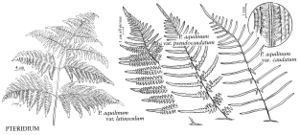Pteridium aquilinum var. pseudocaudatum
Cat. N. Amer. Pl. ed. 2 12. 1900.
Petiole 10–70 cm. Blade broadly triangular to sometimes ovate, 2–3-pinnate-pinnatifid at base, 20–80 × 20–70 cm; blades, rachises, and costae sparsely pilose to glabrous abaxially. Pinnae (proximal) ovate-lanceolate or triangular, distal pinnae oblong; terminal segment of each pinna ca. 6–15 times longer than wide, longer ultimate segments 1–2 times their width apart, ca. 2–5 mm wide. Pinnules at 45–60° angle to costa; fertile ultimate segments adnate or equally decurrent and surcurrent. Outer indusia entire to somewhat erose, glabrous.
Habitat: In barrens and open pine or oak woods in acid, often sandy soil, abundant, forming large colonies
Elevation: 0–1000 m
Distribution

Ala., Ark., Conn., Del., D.C., Fla., Ga., Ill., Ind., Ky., La., Md., Mass., Miss., Mo., N.J., N.Y., N.C., Ohio, Okla., Pa., S.C., Tenn., Tex., Va., W.Va.
Discussion
Pteridium aquilinum var. pseudocaudatum is more common in the southern portion of the range.
Selected References
None.
